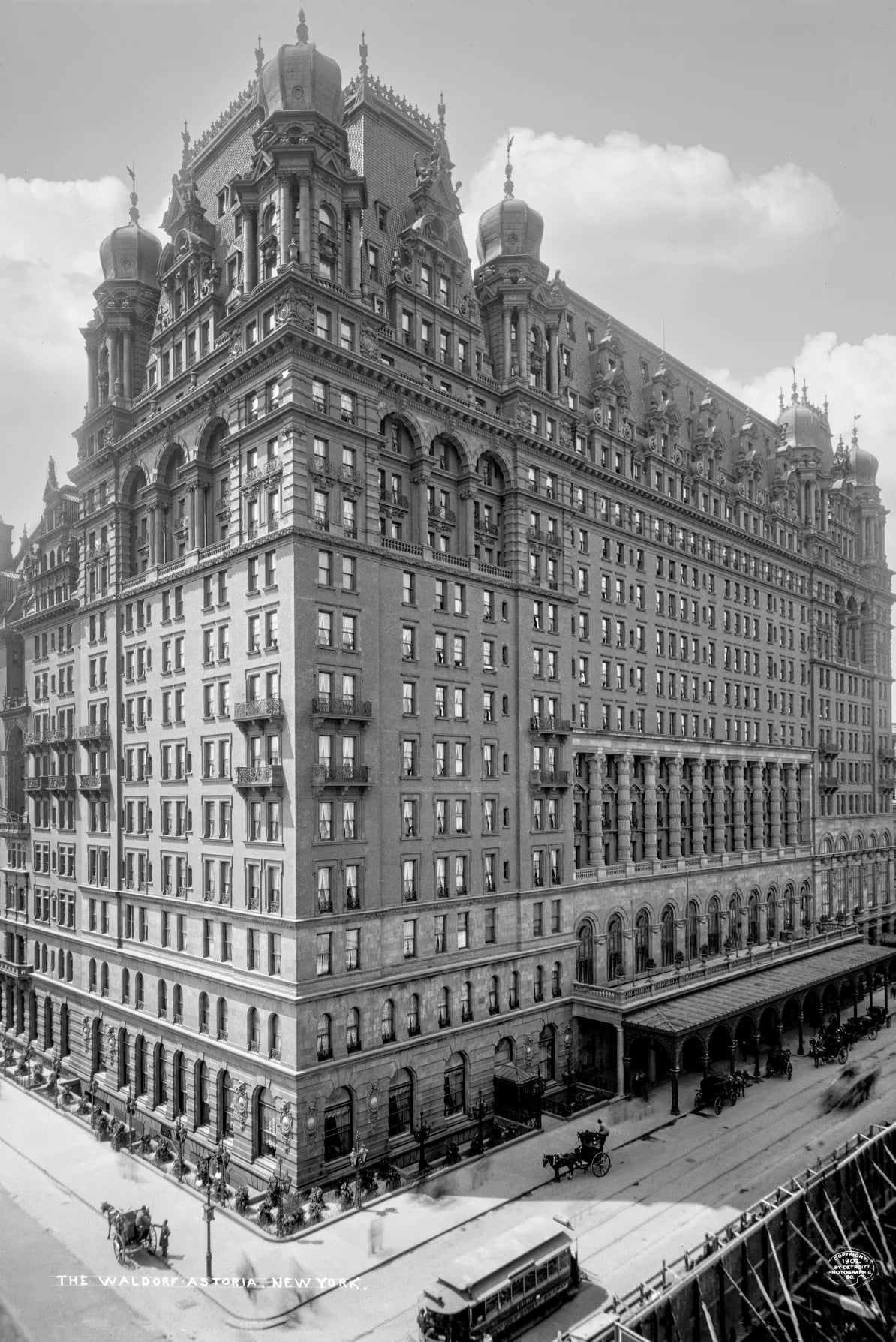Your Cart is Empty
Free and Fast Shipping | 30 Day Money Back Guarantee
Free and Fast Shipping | 30 Day Money Back Guarantee
Free and Fast Shipping | 30 Day Money Back Guarantee

3 min read

In 1893, the Waldorf Hotel was constructed at the corner of 33rd Street and Fifth Avenue by William Waldorf Astor. John Jacob Astor IV, his cousin and competitor, built a taller hotel next door four years later. The two feuding relatives eventually reached a truce and connected their buildings with a 300-foot marble corridor known as Peacock Alley, resulting in the birth of the Waldorf-Astoria.
The Waldorf Hotel stood 225 feet high, had fifteen public rooms, 450 guest rooms, and was heavily furnished with antiques. The Astoria Hotel opened in 1897 on the southwest corner of Fifth Avenue and 34th Street, next door to the Waldorf. It had sixteen stories, twenty-five public rooms, and 550 guest rooms.
In 1902, the two hotels were merged and became known as the Waldorf Astoria. The new hotel was located on the site of the original Waldorf Hotel, which was demolished to make way for the expansion. The new Waldorf Astoria was the largest hotel in the world at the time, with over 1,300 rooms.
The hotels were designed to cater to the needs of socially prominent and wealthy visitors to the city, and were the first to offer electricity and private bathrooms throughout. The Waldorf was known for its fundraising dinners and balls, and its celebrity maître d'hôtel, Oscar Tschirky, known as "Oscar of the Waldorf," authored The Cookbook by Oscar of The Waldorf (1896), which included popular recipes like Waldorf salad, Eggs Benedict, and Thousand Island dressing. The hotels were demolished in 1929 to make way for the Empire State Building, and the current Waldorf Astoria New York was built on Park Avenue in 1931.
Some of the many notable guests were:
Demolition
The decision to demolish the original Waldorf Astoria hotel to make way for the construction of the Empire State Building was made by the hotel's owner, George Boldt. Boldt was the general manager of the Waldorf Astoria at the time, having taken over the position in 1904. He was a well-known figure in the hospitality industry and had previously worked as the manager of the Bellevue-Stratford Hotel in Philadelphia.
Boldt's decision to demolish the Waldorf Astoria was motivated by several factors. One of the main reasons was the desire to build a more modern and luxurious hotel to compete with other high-end hotels that were opening in New York City. Boldt believed that the existing building was outdated and needed to be replaced.
Additionally, the new site of the Waldorf Astoria on Park Avenue was highly desirable due to its central location. Boldt recognized that the site had significant commercial value and saw an opportunity to capitalize on it by building a taller and more profitable structure.
Ultimately, Boldt's decision to demolish the Waldorf Astoria was controversial, and many people lamented the loss of the historic building. However, the construction of the Empire State Building was a major achievement of the 20th century, and it remains an iconic landmark in New York City to this day.
The Waldorf Astoria remained a landmark hotel for many years, but the original building was eventually demolished in 1929 to make way for the construction of the Empire State Building.
The good news is, the Park Avenue Waldorf Astoria is being redeveloped and will re-open as a luxury hotel in 2023 with 400 high luxury rooms.
You can find a link to the Hotel Waldorf Astoria here.
Comments will be approved before showing up.
Tha Quality was fantastic❗❗❗
Used grease or lard bucket was carried under rear axle to periodically grease wheel hubs. Very good video.
I'm super impressed how quickly the print got to Canada and the quality is worth every penny. Thank you so much, Gordon Parks is a hero to my partner and I'm sure he will love this surprise
Received as a gift and could not be happier with the quality of the print. Shipping container ensure this arrived in perfect condition.
Love the simplicity and vintage feel of this print. Plus- prickly + beauty theme.
Wow. What an incredible photograph, and I love the story behind it as well. Seller does excellent work, and I couldn't be more pleased.
Amazing photograph and beautifully reproduced. Excellent work and shipped quickly. Thanks so much.
Beautiful photo and amazing quality!
5 stars review from Claire
Image quality and the extent to which the image was packaged securely was perfect. Could not be happier with the product.
This image along with much of Thomas Hines' work is incredibly powerful. The brutality faced by these children makes our everyday hardships seem frivolous.
5 stars review from Pjewc191
Great item. Packed well for shipping. Shipped quickly.
arrived quickly and looks great!
Classic. Framed it, and hung it up.